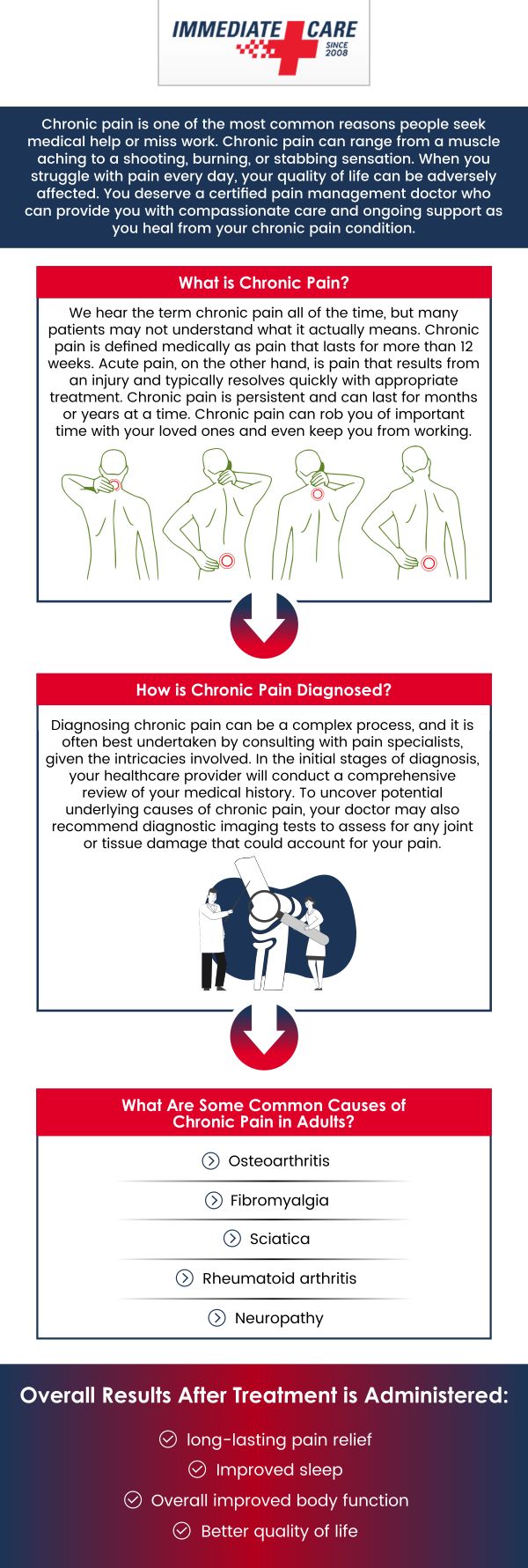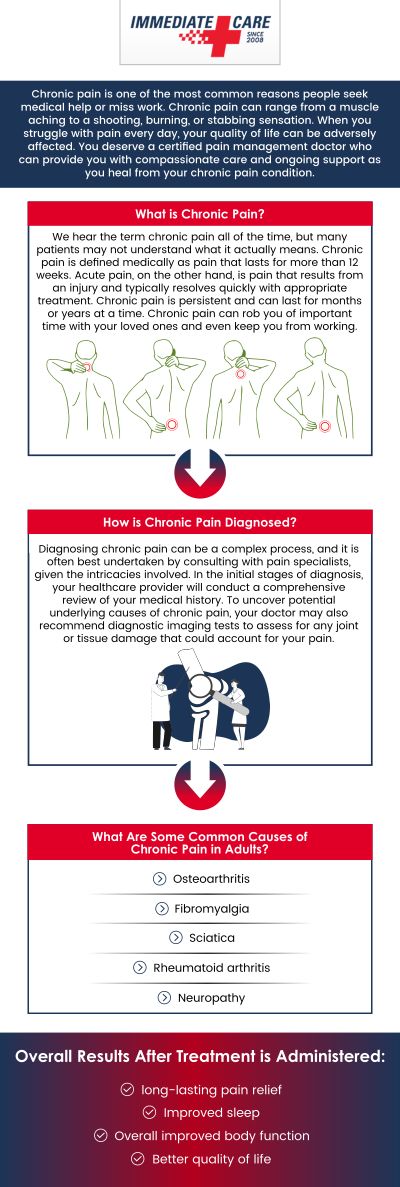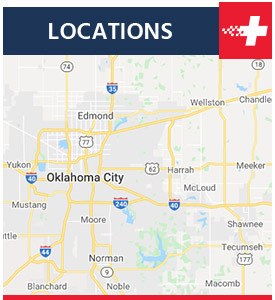Acute Vs Chronic Pain Treatment Clinic Q&A
Acute pain is short-term, typically lasting weeks and usually subsiding within six months, and is caused by specific injuries or accidents. Chronic pain is persistent, lasting longer than six months, and can be linked to conditions like arthritis, fibromyalgia, headache disorders, or nerve damage. Dr. Kevin Penwell (D.O.) and his staff at Immediate Care of Oklahoma diagnose and offer treatment options for acute and chronic pain. For more details, contact us or you can also book an appointment online or simply walk in. We have convenient locations to serve you in Edmond OK, Norman (24th) OK, Norman (HealthPlex) OK, Tecumseh OK, West Moore OK, I-240 and Sooner RD OK, Yukon OK, and Choctaw OK.




Table of Contents:
What conditions cause acute pain?
Do chronic illnesses cause pain?
What is the difference between acute and chronic pain?
What pain level is considered severe?
At Immediate Care of Oklahoma, our dedicated team is committed to providing comprehensive treatments tailored to address both acute and chronic pain. With an understanding that pain management requires a multifaceted approach, our clinic employs the latest in medical advancements and therapies. Whether you’re experiencing sudden pain from an injury or suffering from long-term pain issues, our specialists are equipped to assess your condition and create a personalized treatment plan aimed at not only alleviating pain but also improving your overall quality of life.
Acute pain often serves as a signal from the body indicating injury or an underlying issue needing immediate attention. This type of pain can arise from various conditions, such as accidents or falls leading to broken bones, sprains, and lacerations. Surgical procedures are another common source of acute pain as the body responds to the trauma of surgery. Dental problems, such as abscesses and tooth extractions, can also precipitate acute pain sensations. Infections, whether they’re in the skin, organs, or other body parts, can trigger sharp, immediate pain as well. Burns, ranging from minor superficial burns to severe ones, are characterized by acute pain due to the damage inflicted on the skin’s nerve endings. Essentially, acute pain acts as an alarm that encourages individuals to seek medical help to address the cause of discomfort.
Yes, chronic illnesses can be a significant source of pain for many individuals. Unlike acute pain, which is temporary and often linked to a specific injury or condition that heals over time, chronic pain persists for months or even years and can be present without an apparent immediate cause. It often stems from conditions such as arthritis, fibromyalgia, migraine headaches, and neuropathic pain disorders, where the nervous system signals pain abnormally. Chronic pain can also arise from ongoing illnesses like cancer, diabetes, and multiple sclerosis, where pain becomes a constant reality affecting an individual’s daily life and well-being. This type of pain not only challenges the physical body but can also have profound psychological effects, leading to mood changes, anxiety, and depression, further complicating the individual’s quality of life and ability to manage their health.
Acute and chronic pain differ primarily in terms of duration and cause. Acute pain typically signals that the body is experiencing injury or illness, serving as an immediate reaction to a specific event such as surgery, accidents, or infections. It is characterized by its sudden onset and usually lasts for a short duration, subsiding as the underlying cause heals. This type of pain is often described as sharp or severe, prompting individuals to seek timely medical intervention to address its source and prevent further complications.
On the other hand, chronic pain persists beyond the normal healing time, lasting for months or even years, and in many cases, it continues without a clear cause. Unlike acute pain, which resolves once the injury heals, chronic pain can persist, often due to conditions such as arthritis, fibromyalgia, or neuropathy, where pain signals in the nervous system malfunction. Chronic pain is not only a physical condition but also affects emotional and mental health, leading to challenges such as fatigue, mood disturbances, and reduced quality of life. The management of chronic pain often requires a comprehensive approach that includes medication, physical therapy, and psychological support to help individuals cope with its long-term effects.
Pain severity is subjective and varies significantly from one individual to another, but pain that reaches a level considered to be “severe” typically profoundly impacts daily activities and quality of life. Severe pain is often described on pain scales (ranging from 0 to 10) as 7 or higher. This intensity of pain can be so debilitating that it interferes with a person’s ability to perform basic tasks, concentrate, and even rest or sleep. It may manifest as a constant, intense ache or sharp, excruciating bursts that are challenging to manage with over-the-counter medication alone. Severe pain can stem from a variety of medical conditions, surgical procedures, or injuries, and it requires a thorough assessment by healthcare professionals to determine the most effective treatment strategies. In cases of severe pain, treatment usually involves a combination of medications, such as opioids or non-steroidal anti-inflammatory drugs (NSAIDs), alongside other therapies, including physical therapy, psychological support, and sometimes surgical interventions, depending on the underlying cause.
At Immediate Care of Oklahoma, we understand the complexities of managing both acute and chronic pain and the impact it can have on every facet of your life. Our team of specialists is dedicated to providing you with the most effective pain management solutions tailored to your unique needs. Don’t allow pain to take control of your life. For a comprehensive evaluation and to explore the options available to relieve your pain, call us or book an appointment online today. We are committed to helping you achieve a better quality of life, free from the limitations of pain. We have convenient locations to serve in Oklahoma City, OK. We serve patients from West Moore OK, Norman (HealthPlex) OK, Norman (24th) OK, Edmond OK, Yukon OK, I-240 & Sooner RD OK, Tecumseh OK, and Choctaw OK.


Additional Services You May Need
▸ Urgent Care Services
▸ Illness + Injuries
▸ On Site Lab + X-Ray
▸ Helpful Health
▸ Motor Vehicle Accidents
▸ Drug Testing
▸ MRO
▸ UTI Treatment
▸ Employment Physicals
▸ Workers Comp
▸ Strep Throat Treatment
▸ Pregnancy Testing
▸ Blood Pressure Testing
▸ Urinalysis
▸ Mononucleosis Treatment
▸ Suture Removal
▸ Respiratory Syncytial Virus
▸ OccMed








